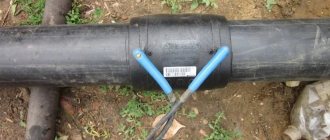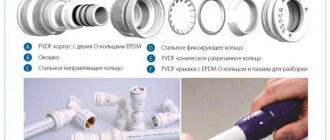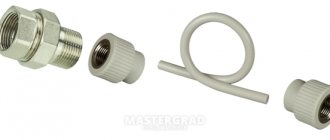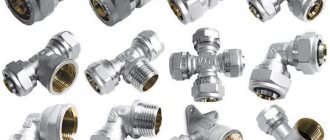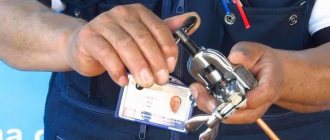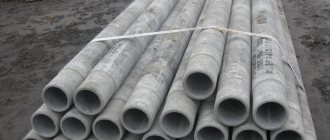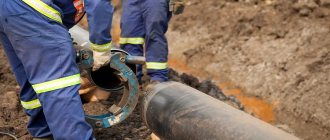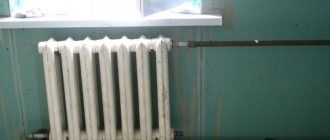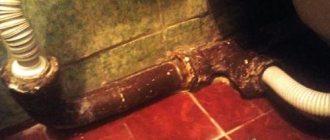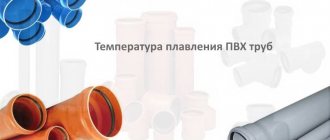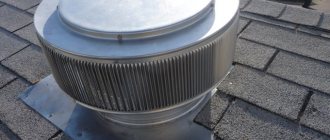Modern polymer materials used for the manufacture of pipes have practically replaced steel pipelines in households; when laying highways, special methods and technologies are used to change the configuration of the line and increase its length. The connecting coupling for pipes is designed for tight and durable mating of joints in straight sections; for effective operation, its technical characteristics must correspond to the parameters of the main line.
Unlike industrial connections using soldering, welding, flanges, the pipe coupling is most widely used in the installation of cold and hot water supply lines, sewerage, and heating in individual construction. Thanks to modern developments, it has become possible to lay communications from popular materials: cross-linked metal plastic (PE-X) and low-density polyethylene (HDPE) without the use of complex technical processes and specialized construction tools.
If you know the rules for installing pipeline systems, any homeowner can install a polymer pipeline with their own hands (with the exception of polypropylene, where soldering is required) using different types of fittings - this will save significant financial resources if necessary.
Rice. 1 Push coupling for pipes - appearance and design
Clutch - what is it, purpose, features
A plumbing coupling is a special element for connecting pipe sections in difficult sections of the pipeline route. It is used both for laying a new highway and for repairing an existing one. In the standard version, the coupling looks like a piece of pipe, the edges of which, depending on the method of fastening, can be equipped with internal or external threads. By design, it can be straight, rotary, as well as for a triple or quadruple connection, and by structure - monolithic or composite. It is made of various materials - just like the pipes for which it is used for joining.
The main purpose of couplings is a quick, reliable, safe and durable connection of pipe sections into a single pipeline. This method does not require the use of special equipment and complex technologies, such as electric welding. This type of docking can be used in a variety of cases. In everyday life, they are used to install both water supply and sewerage, heating and drainage systems.
Joining a polyethylene pipe with an electric welded coupling Source sgrupp.ru
The type of fastening of the device directly depends on the material:
- Metal - carving.
- Plastic and polymer – soldering.
- Metal-plastic – compression method.
In addition, there are more modern push couplings. The method of joining them is alternative to the traditional compression-crimp method - the pipe is simply inserted into the product until a characteristic click occurs.
Compared to traditional methods, the coupling of pipes has the following number of advantages:
- Ease and high speed of the docking procedure.
- Minimum weight.
- Wide variety in shape, structure and material.
- Availability.
- Possibility of quick dismantling (for threaded connections).
- Versatility in use.
- Resistance to loads.
- Optimal cost.
- Long service life.
- Reliability.
The disadvantages of such devices may appear due to the specific operating conditions. For example, a connection may become loose and leak due to vibration. Also, some types of materials quickly deteriorate under the influence of temperature changes.
Threaded coupling device Source gidroguru.com
Connecting coupling for plastic pipes
Plastic products are widely used in individual construction and currently completely replace not only steel pipeline communications, but also many types of fittings, and for connecting HDPE in everyday life, plastic is the main component.
In a private house, a polymer pipeline made of cross-linked polyethylene and metal-plastic operates in heating systems, underfloor heating, hot and cold water supply. Ordinary polypropylene and its varieties (reinforced with fiberglass or PP-R aluminum) are widely used for heating and supplying hot and cold water to the house.
Internal sewage systems are installed from polyvinyl chloride (PVC) polymers, and outdoor sewer pipes (orange) are made from unplasticized polyvinyl chloride (UPVC).
Water pipes made of low-pressure polyethylene (HDPE pipes) are used to supply cold water to the house; in the industrial sector, polyethylene is a material for outdoor sewer lines and for laying gas lines.
In all the above examples, for domestic use, joining is carried out using couplings; special equipment is required for soldering polypropylene or installing press fittings.
Rice. 5 Compression coupling for HDPE pipes
Compression and press couplings for HDPE and metal-plastic PEX
HDPE pipes are used to organize individual water supply; they are used to supply water to a house from a well or a well, if the water intake is carried out by a submersible electric pump or station located in a caisson.
A solid line is laid underground without breaks, the water supply is connected only at the exit from the well and the entrance to the house, very often a polyethylene section is used as a pressure line and is connected to an electric pump, removed from the well head.
In all of the above cases, pipes are connected using plastic fittings; the peculiarities of their installation with a coupling are that they not only connect pipe sections, but also ensure their connection to the equipment.
Metal-plastic is also connected in a similar way, taking into account that a crimp connection on a union nut is not a very reliable method - a nut without a spring ring is subject to self-unscrewing and over time (after 5 - 7 years) a small leak may appear. Therefore, this technology is used only when the line is located externally in the area of visibility and direct access - if drops are detected at the junction, you can always tighten the nut.
Varieties by design and purpose
According to the type of design and purpose, couplings are divided into 2 main types:
- Connecting.
Classified into 2 categories:
- Pipe-to-pipe type. Designed for joining sections of equal diameter.
- Transitional. Used to connect pipes of various diameters.
Both types are used for assembling one-piece or collapsible pipelines. In the first case, a glued or welded model is used for installation, in the second - a threaded one. In this case, one of the prerequisites for creating a tight, reliable connection is that the type of material of the pipe matches the fitting.
- Combined.
Combined type couplings are used to connect pipes made of different materials. Moreover, they are divided into the following subtypes:
- With internal thread. Used for plumbing and heating systems.
- With external thread. The open part with threaded thread allows for more convenient installation of pipes. As a rule, they have a wide variety of sizes.
- Detachable type or “American”. Makes it possible to connect and disconnect both hard and soft types of pipelines.
Connecting a plastic pipe with a detachable coupling Source stroy-podskazka.ru
Note! When selecting a coupling for a specific application, it is critical that it be made of a material similar to the type of pipe being connected. Otherwise, the connection will not be reliable and will weaken or completely collapse over time.
For MTZ
The purpose of this type of coupling is to retain fluid in the system when a rupture occurs. This type is used in tractors. Additionally, these elements are designed to protect the system from contamination. The convenience of hydraulic couplings lies in the simplicity and speed of connecting lines. These elements, among other things, prevent the high-pressure hoses from twisting.
| d1 | d2 | d3 | a |
| 16 | 16 | 19 | 1.5 |
| 16 | 14 | 19 | 1.5 |
| 18 | 18 | 20 | 1,5 |
| 20 | 20 | 24 | 1,5 |
Varieties by material
Based on the type of material of the pipes being connected, couplings are divided into the following types:
- Steel.
- Cast iron.
- Copper.
- Plastic and polymer.
Let's look at the features of each of them in more detail.
For steel pipes
Steel water pipes are most popular in private households. Therefore, fittings of the type in question are also very common for them. They are divided into two main types:
- Threaded.
They are essentially a steel cylinder with threads on the inside. Pipe installation is carried out by screwing on both sides of the coupling. The main advantage of such a joint is high mechanical strength, and therefore reliability and durability. However, there is also a significant drawback - due to susceptibility to corrosion, the threads can rust and become permanent.
Steel threaded couplings Source prom.st
See also: Catalog of companies that specialize in engineering systems (heating, water supply, sewerage and others) and related work
This is especially true for cold water pipes. The constantly formed condensate slowly but surely contributes to corrosion processes. This can be avoided if, instead of purely steel products, analogues made of brass or cast iron are used. Their advantage is better protection against rust, ease of installation, versatility and affordable cost.
- Compression.
It is intended primarily for cases where the connected sections of the pipeline do not have a thread, or it is damaged, or it is not possible to cut it. When properly installed, a compression coupling for a steel pipe allows you to achieve a high degree of joint tightness.
Their characteristic feature is the great variability of combinations of connections made - internal or external threads, the possibility of joining pipeline sections of different materials and diameters, as well as connecting taps, valves and other components.
Main advantages:
- Creating a detachable connection that, if necessary, allows you to easily replace any element.
- Joining metal pipes without threads.
- Versatility.
Metal compression couplings Source alicdn.com
However, they also have disadvantages - during installation, preliminary cleaning of the edges from rust or paint is required. In addition, it is impossible to create the most durable joint based on them. Therefore, in most cases they are used for temporary connections.
Recommendation! Compression fittings are recommended for use in the repair of old pipelines, where the use of threading or electric welding is unacceptable due to further destruction of the material.
For cast iron pipes
Pipelines based on cast iron have still not lost their relevance when arranging a private autonomous sewage system - they are strong, durable and not subject to corrosion. However, due to the specifics of the material, it is best to join such metal pipes using the following couplings:
- Sliding. Hidden technology is used for installation. Disconnection will no longer be possible.
- Rolled for repair. Consist of two parts with a rubber gasket inside. Connected using clamps. They are used for sections of the highway that require frequent repairs.
- Plastic. They differ from others in that they can be used repeatedly.
Roll-type coupling made of cast iron for pipeline repair Source gvk.ru
Rubber seals are well suited for joining cast iron pipes, as well as the time-tested method of joining by hammering.
For copper pipes
Couplings specifically designed for joining copper pipes are the most reliable, durable and strong, but at the same time they are more expensive compared to analogues. According to installation features, they are divided into 4 main types:
- On the thread.
- Compression.
- Capillary.
- Press fittings.
A prerequisite for long-term trouble-free operation of copper pipelines is the copper base of the fitting. Couplings made from other materials can also be used, but only as a temporary alternative until suitable copper connectors can be installed.
Copper coupling for connecting pipes Source cloudinary.com
Types of coupling connections
The drain coupling (MS) is designed to provide a quick and, most importantly, hermetically sealed connection of drain installations at gas stations and oil depots with drain hoses. The most common passage diameter in millimeters for MS is 80. The MS-80 drain coupling is made exclusively of aluminum, which has proven itself in gasoline environments.
MC-80 is available with a G3-A threaded connection. The drain coupling is connected to the drain device itself via a pipe (MS-80). If the design has a drain filter, then the drain coupling MS-80 is connected to it using a sealing seal.
MS-80 can have different resistance to climatic factors, and therefore is manufactured in different versions: UHL, U and T. The MS-80 drain coupling operates under conditions of ambient temperature from -50 to +50 degrees and humidity no more than 95%. The use of MS-80 in hydraulic systems is limited to a pressure of 0.6 MPa.
Drain coupling
The Gebo pipe-to-pipe coupling is used primarily in places where it is not possible to cut threads or where it is difficult to do so. If you need to change a section of pipe or, for example, install a meter, so as not to break the tiles, just install the Gebo design.
Gebo technology uses a clamping mechanism that allows for quick and tight connections. The Gebo design itself consists of the following elements:
- 2 nuts;
- clamping ring;
- clamping ring;
- sealing ring;
- coupling
Gebo connections are used in systems with operating pressures for water up to 10 bar, and for gas up to 4 bar. Gebo technology allows you to connect plumbing elements that do not lie on the same axis with a maximum deviation of 3 degrees.
If a permanent blind connection is required, a flange coupling is a good choice. First of all, such a pipe-to-pipe coupling is used to connect smooth pipes with flanged elements of a water supply system. The flange coupling has the shape of a cylinder, on one side it is designed as a crimping mechanism, and on the other it has a flange mount. The material of manufacture is predominantly cast iron.
Threadless compression/clamp connection GEBO / GEBO (video)
Repair couplings
Repair coiled couplings are made of cast iron and are used to eliminate damage and accidents on steel and cast iron pipelines. Repair couplings can repair damage such as fistulas, cracks and even complete splits in pipelines with a diameter of 80 to 300 millimeters. Repair couplings make it possible to quickly repair a pipeline when exposed to severe weather conditions.
Repair and emergency restoration work on external and underground communications does not require special tools if a repair coupling is used. The pipe-to-pipe repair coupling allows you to eliminate leaks while maintaining the operating pressure in the pipeline. Repair connections provide mechanical fixation of pipes to avoid axis shifts and possible splitting of the structure.
Video description
Video review on the selection and use of compression threadless steel coupling:
With proper installation and compliance with operating conditions, polyethylene fittings will last for more than a dozen years.
- Plastic.
The easiest fittings to use. They are cylinders with sealing material around the edges. For installation, you must first remove the outer chamfer from the pipes to be connected, and then simply put the couplings on them. If necessary, it is allowed to use special glue or sealant.
Important! Fittings based on polyethylene and polypropylene are mostly disposable. The exception is products combined with metal, the body of which does not change its characteristics during installation.
Installation features
The reliability and durability of pipe joining is ensured by a technically competent installation procedure. There are the following features of coupling connections of pipelines made of various materials:
- Flange connection.
The method is used for sections of metal pipes of maximum diameter. First one and then the other half of the fitting is mounted alternately on the area to be connected. The connection point is in contact with a ring of elastic material.
Cast iron and copper couplings
There are special fittings for connecting this type of pipeline, but installation in this case is quite complicated. Firstly, it is imperative to be able to get close to the pipe from each side, otherwise it is impossible to ensure the tightness of the joint. If the pipeline is laid near a wall, you will have to hollow out part of it near the connection point. Secondly, all work must be done very carefully and focused. It is highly advisable that the installation be carried out by an experienced person, since such work may not be possible for a beginner.
Installation is carried out as follows.
- First, the joint is sealed with bonding.
- The pipe is inserted into the fitting until it stops. This is necessary so that the seal does not fail.
- The bondage is being minted. This must be done in several turns and each turn must be minted around the entire circumference.
- After embossing, it is necessary to cover the joint with cement mortar.
You can also mint it with a simple screwdriver.
Important! Do not neglect the embossing of the seal. If you limit yourself to cement mortar, the connection will not last long. After some time it may leak.
Video description
Video instructions for installing the coupling on a polymer pipe:
- Installation of compression elements.
Initially, the fitting is unscrewed so that it can be conveniently placed on the pipes. Also, marks are made on them in advance for the exact location of the joining element. In this case, the surface must be lubricated.
When the coupling is installed and its position relative to the edges is adjusted, the union nut is tightened. The resulting connection is comparable in strength to a welding seam.
- Installation of electric welded couplings.
Installation is carried out according to the following algorithm:
- The surfaces of the joined sections are pre-cleaned and smoothed.
- The coupling is installed on the edges of the segments.
- Next, power is supplied to the contacts from a special device.
- As the element heats up, the plastic melts and is welded under pressure.
After about half an hour, a strong permanent joint is formed.
Video description
Video on how to properly install crimp couplings on metal-plastic pipes:
- Installation of couplings on cast iron pipes
In most cases, the caulked coupling method is used for joining cast iron pipes. To do this, take a coupling with expansion on both sides. After inserting the segments into the socket, the expanded parts are compacted.
For this purpose, special compounds are used - cable, graphite gland, cement mortar or asbestos cement. In this case, filling is carried out only after the pipeline is firmly installed. Otherwise, cracks and depressurization of the joint will occur.
- Installation of couplings on steel pipes.
The joining of steel pipes is preceded by the alignment of the joined edges. Next, markings are made to position the coupling as evenly as possible during installation. After this, the edges of the segments are lubricated. Then, first the fitting is put on one pipe, then on the other. After this, they are finally consolidated and checked.
On a note! Pipelines made of any other suitable materials can also be connected using couplings. For example, ceramics, asbestos cement, etc.
Briefly about the main thing
The coupling for connecting sections of pipeline is a straight or angled pipe made of a material corresponding to the pipes being joined. Depending on the application conditions and the characteristics of the pipes, joining can be done by threading, soldering, crimping or compression.
Compared to traditional techniques, connecting pipes with a coupling has a number of advantages - lightness, speed, low weight, variety of shapes, sizes and materials, accessibility, dismantling, versatility, durability, low price, reliability and durability. Disadvantages manifest themselves in specific conditions of use.
According to their design features and purpose, couplings are classified as pipe-to-pipe couplings, transition couplings, or combined couplings. According to their purpose for pipes made of a specific material, they are divided into the following types:
- Steel.
- Copper.
- Cast iron.
- Polymer and plastic.
The installation of couplings in each specific case has its own specifics and must be carried out in compliance with the appropriate technology.
Ratings 0
Steel pipe couplings
Connections for steel pipes come in several varieties; the simplest is a cylinder made of steel, cast iron, stainless steel or brass with an internal thread.
The disadvantage of this type is the need to rotate one of the sections of the connected pipe around its axis, so this type is used only when working with short sections.
To transition from internal to external threads, fittings are widely used - types of threaded fittings made in the form of a hex nut or bushing with a small diameter internal thread and a larger external thread.
Rice. 10 Couplings for metal and fittings
To join the ends of fixed pipes in a line, the following types of connections are used:
Sgon. The product is a piece of pipe with a double-sided external thread of different lengths; to connect the pipe ends, the bend is screwed into the pipe with a short thread, and the other end is connected using a coupling placed on the long threaded section. The coupling is screwed onto the external thread of the connected pipe and secured with a lock nut, wrapping a thick layer of tow into the place of fixation.
Compression coupling. Gebo couplings operate on the principle of metal-plastic compression fittings; their design includes a clamping ring with a slot, which is tightened with a union nut. Unlike fittings for cross-linked polyethylene, where the ring compresses and tightly seals the plastic polymer surface, in a metal product due to its rigidity this is not possible, so the Gebo design additionally includes a rubber sealing ring.
Rice. 11 Coupling for Gebo pipes
Cast iron couplings for sewerage
When sewer pipes are made of cast iron, they are connected using a socket joint in the same way as PVC sewer pipes; a typical coupling is a piece of pipe with double-sided sockets. This type of coupling joint is sealed with rubber rings or caulking - the old-fashioned method, when hemp or flax rope impregnated with bitumen is pushed into the joint gap and then covered with cement mortar.
